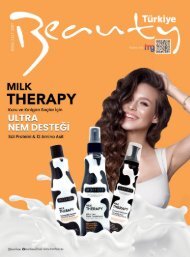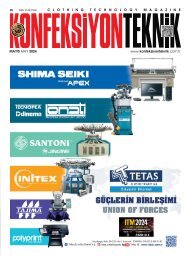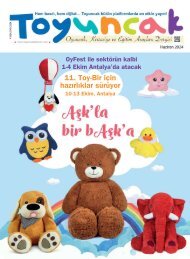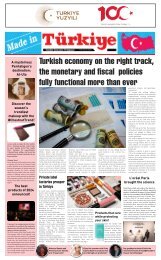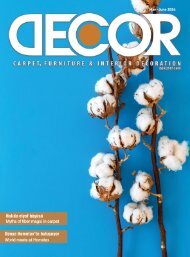You also want an ePaper? Increase the reach of your titles
YUMPU automatically turns print PDFs into web optimized ePapers that Google loves.
or other objects made of small figurines and various
objects, animal sculptures or reliefs have been made.
Similar examples had been obtained by processing
or shaping over the wood.Also it is possible to see on
the textures the extensions of the figurative compositions
at the state of calm or struggling, applied on the
felt. Sometimes we see that the animal figures, which
had been cut from leather and affixed as appliques,
have spread to a very wide area, by going to a strong
stylization.
A new page in the history of archeology and art
A carpet, which was stylized in this way and enriched
with patterns, into which legendary animals added,
dated 5th-1st century B.C., was found in near dates
and it was accepted as “the world’s oldest carpet”.
This rug, which Russian archaeologists C. İ Rudenko
found in Pazyryk highland in the south of the Altay
Mountains in east of Kazakhstan, has been evaluated
as a common product of Central Asian cultures in
terms of technique, motif, pattern, color and composition.
It had influence also in the obtaining of new ideas
in terms of archeology and art history.
The grave robbery, which began in the centuries
before christ in various regions of Central Asia, chose
also this kurgan that was excavated by Rudenko, as
a target and this kurgan was also been robbed in an
unknown date. Waters leaking into the grave after the
robbery had frozen here, and had ensured the carpet,
the items and objects, which remained from the
robbery, have reached the present day in a stiffened
state. If freezing has not occurred, perhaps the
objects in this kurgan would have also decayed over
time and we would have been lack of evidence of the
carpet history. Maybe we would continue to suggest
other dates in this respect. The important thing, that
draws our attention here, is that this rug suggests a
very advanced period in terms of technique, pattern,
color and composition. So this rug is not a simple
carpet and it shows the highest level reached by an
art understood that its infrastructure is based on the
period at least 5-6 centuries ago. Another Russian
archaeologist, who has stated a similar evaluations
that carpet making has been known in the region of
Khoplin for two thousand years and that their original
homeland was Western Turkistan.
Turkish knot “Gördes”
This rug, which is at St. Petersburg Hermitage
Museum today, is technically woven by the Turkish
(Gördes) knot. The carpet, which was woven from very
fine and double-twisted wool, shows that it was woven
very intensely and in good quality for a special person.
In addition, while the reflections related to Turkish
culture come to the forefront in the designs on the
carpet, the effects of Western Iranian and Mesopotamian
cultures are also seen from place to place.
Kurgans, which are located on the Silk Road, which
had undoubtedly provided a very important transportation
between the East and the West during the First
and Middle Ages, were made by the Central Asian peoples
who were affected by the passengers, who had
come and gone on this route. The patterns and shapes
prominent on the carpet are seen in the middle area
along with five borders surrounding the carpet. On the
outermost and innermost narrow border, the mythological
griffon figures, which are widely reflected in
the art works of Eastern societies, are sorted. Snowflake
patterns takes place on the second border placed
from outside towards inside on the second border,
and the cavalry compositions in state of moving
ahead were included on the third border. While these
cavalries bring to mind; the patterns of Mesopotamian
and Sassanic cultures from place to place with their
skinny-leg shalwars on their bodies and their headwears,
which are open from front and closed from
rear, over their horses in highly ornamented trappings
with knotted tails, ornamented manes and aigrettes
put on their heads, they also present images related
to living ways of Central Asian Turkish communities
from place to place.On the fourth border inside, the
deer sequences passing through a marshy land in the
same direction are included. In addition to that deers
are animals common to Siberia, the figures over
their forearms and rear hips such as points, commas
reflect the common features of Eurasian animal style.
There are equal squares in size of 6x4=24, filled with
snowflakes or animal skin patterns in the middle of
the rug. However, differences are seen between the
ground color and the pattern color among similar
patterns. In the general sense, the dominant colors of
the Pazyryk Rug consist of white, blue and yellow on a
red background.There is a long gap between the other
carpet pieces that came to hand after the Pazyryk Rug
which refers a very good quality and advanced period.
However, this gap does not mean that carpet was not
November - December 2019 • DECOR 17



